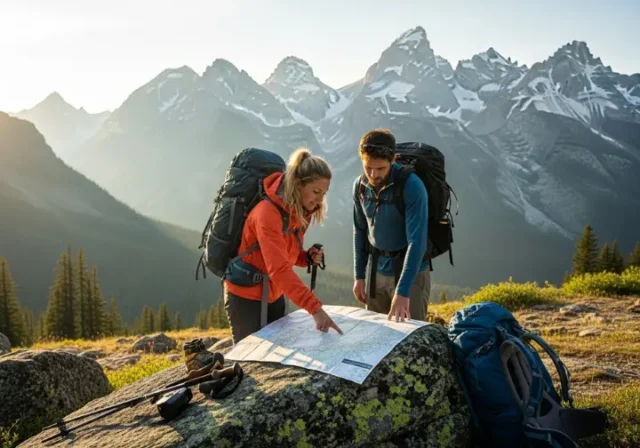In this article
Hiring a guide for a backcountry adventure means placing your safety and security in a stranger’s hands. It’s an act of profound trust. While many articles offer simple advice, this guide moves beyond that, providing a step-by-step verification process to empower you. Our goal is to equip you with the tools and knowledge to confidently vet and choose a qualified, compatible, and professional backcountry guide who is the right fit for your objective.
This isn’t just about finding a guide; it’s about finding your guide. We’ll show you how to decode the complex world of professional certifications, independently verify a guide’s credentials, assess for the crucial element of personal compatibility, and finalize your trip with the confidence that comes from diligent preparation.
Why Do Professional Guiding Standards Matter?
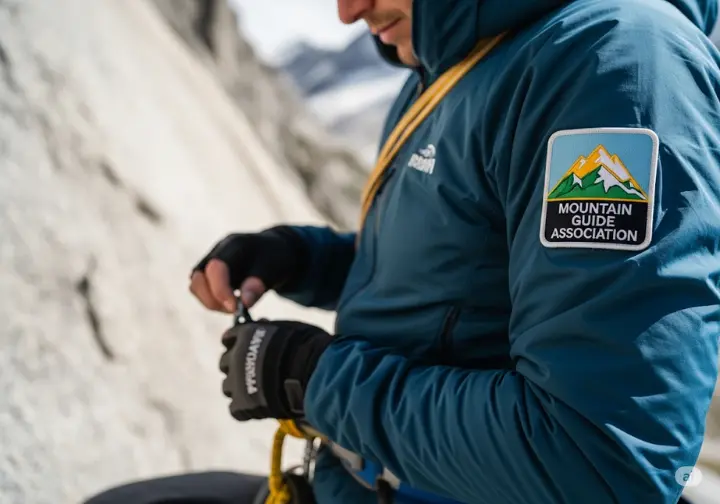
Before you can vet a guide, you need to understand the landscape they operate in. The world of professional guiding is built on a framework of rigorous training, standardized assessment, and public accountability. Understanding this framework is the first step toward making an informed, safe decision. It’s the difference between hoping you have a professional and knowing you do.
Who are the Key Certifying Bodies in Mountain Guiding?
Not all certifications are created equal. In the world of mountain travel, a few key organizations set the global and national benchmarks for professional competence. Recognizing these names is your first filter for quality and safety.
- The International Federation of Mountain Guide Associations (IFMGA) is the undisputed pinnacle of the profession. This is the “gold standard.” An IFMGA-licensed guide has achieved the highest level of certification in all three core disciplines—rock, alpine, and ski guiding—and possesses the legal recognition, known as the carnet, to work across international borders. To understand the IFMGA’s role as the exclusive international federation, is to understand the peak of the profession.
- The American Mountain Guides Association (AMGA) is the sole U.S. organization recognized by the IFMGA. It provides the rigorous training and certification pathways in the Rock, Alpine, and Ski disciplines that can ultimately lead to full IFMGA status. If you are hiring a guide in the U.S., their qualifications should trace back to the AMGA.
- The Association of Canadian Mountain Guides (ACMG) serves as the professional standard-bearer in Canada. As another member of the IFMGA, its standards for training and certification are similarly stringent, ensuring a high level of competence for guides working in Canada’s vast mountain ranges.
Knowing these organizations allows you to decode a guide’s qualifications and ensure they align with the foundational principles of responsible hiking and internationally recognized safety protocols.
What’s the Critical Difference Between a Certified Guide and an Accredited Business?
This is one of the most critical and commonly misunderstood distinctions in the industry. A mistake here can lead to a false sense of security. It’s essential to understand that you are not hiring a business to keep you safe; you are hiring an individual.
- Individual Certification applies to a person. It is hard-won proof that a specific guide has passed demanding, multi-day exams evaluating their technical skill, rescue abilities, risk management judgment, and client care in a specific discipline. An AMGA Certified Guide has proven their personal competence.
- Business Accreditation applies to a company or guide service. The AMGA accredits businesses that adhere to professional operational standards, carry appropriate insurance, and have robust risk management policies in place.
An accredited business is required to use appropriately trained staff, but—and this is the key—it does not guarantee that the specific guide assigned to your trip is fully certified for that objective. The ultimate responsibility falls on the client to perform the necessary checks and vet the qualifications of the individual guide they will be tied into a rope with. You can confirm the AMGA’s official definitions of accreditation and certification directly on their site.
How Do You Systematically Vet a Guide’s Credentials?
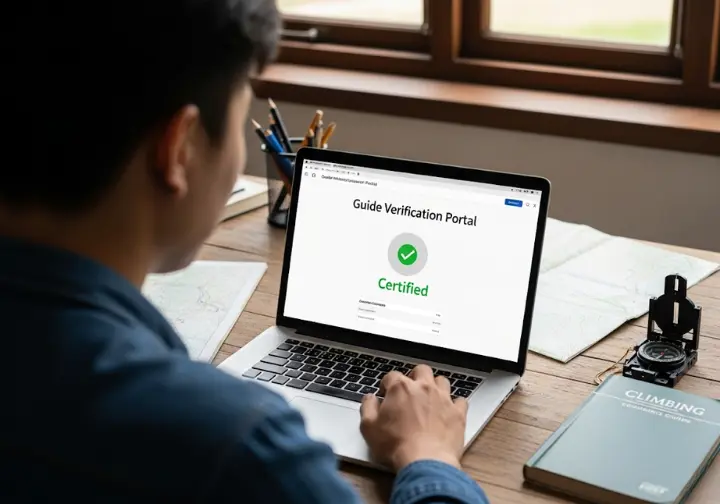
This is where you move from passive consumer to empowered client. The core of vetting a guide is a simple, actionable workflow that leverages public databases to confirm qualifications. This complete verification process removes all guesswork and ensures the person you hire is exactly who they claim to be.
How Can You Independently Verify a Guide’s Certification Online?
The single most important step in this entire process is to “Trust, but Verify.” A guide’s website can say anything; the official databases tell the truth. Do not rely on a bio alone. Use the free, public search tools provided by the governing bodies for this crucial identity verification.
- For IFMGA Guides (Worldwide): Use the official IFMGA guide search portal. You can search any guide by name and their national association to confirm they hold the full international carnet. This is the ultimate authentication of their global credentials.
- For U.S. Guides: Use the “Hire a Guide” search tool on the AMGA website (
amga.com). This is the definitive source. You can look up any individual to see their exact, current training and certification level in each discipline. - For Canadian Guides: Use the “Find a member” tool on the ACMG website (
acmg.ca). This allows you to confirm their active membership status and specific qualifications.
This act of verification is a skill, much like mastering digital tools for route planning. It is a fundamental part of modern, responsible backcountry travel.
| Organization | Verification Portal | Step-by-Step Instructions |
|---|---|---|
| IFMGA (Global) | searchguides.ifmga.info | 1. Enter the guide’s last name. 2. Select their National Association (e.g., AMGA for USA). 3. Confirm their status appears as “IFMGA Mountain Guide.” |
| AMGA (USA) | amga.com/hire-a-guide/ | 1. Enter the guide’s name in the search bar. 2. Review their profile for “Certified” status in the relevant discipline (Rock, Alpine, Ski). |
| ACMG (Canada) | acmg.ca/member-search.aspx | 1. Enter the guide’s name. 2. Verify their membership is “In Good Standing” and check their listed certifications. |
How Do You Decode the Different Levels of Guide Certification?
Certification isn’t a single event; it’s a demanding progression involving many steps that often takes 5-7 years of dedicated training and mentorship. Each level has a specific scope of practice, and matching the guide’s certification to your objective is crucial for safety and quality.
- A Single Pitch Instructor (SPI) is certified to teach rock climbing in a top-rope or single-pitch environment. They are not certified for multi-pitch terrain.
- An Apprentice or Assistant Guide has passed their initial courses and is in the training pipeline. They have foundational skills but must work under the supervision of a fully certified guide.
- A Certified Guide (Rock, Alpine, or Ski) is a fully qualified professional. They have passed the final, rigorous exam in at least one discipline and can independently lead clients in that specific type of terrain.
- An IFMGA / American Mountain Guide has reached the summit of the profession, achieving full certification in all three disciplines. They represent the most experienced and versatile guides in the world.
This hierarchy, detailed in programs like the ACMG’s overview of their Training and Assessment Program, ensures that guides are not overstepping their proven abilities. This is especially important when you are progressing into more technical terrain like scrambling and require a guide with the appropriate qualifications.
| Certification Level | Scope of Practice | Typical Activities |
|---|---|---|
| Single Pitch Instructor (SPI) | Top-rope and single-pitch rock terrain only. | Introductory rock climbing, gym-to-crag courses. |
| Apprentice/Assistant Guide | Works under direct supervision of a Certified Guide. | Assisting on introductory courses, second guide on larger groups. |
| Certified Guide (e.g., Ski) | Independent guiding in one specific discipline. | Guided backcountry skiing, glacier travel, ski mountaineering. |
| IFMGA Mountain Guide | Independent guiding in all disciplines (Rock, Ski, Alpine). | Complex multi-day alpine climbs, international expeditions, high-altitude skiing. |
What Essential Medical and Avalanche Training Should a Guide Have?
Technical guiding skill is only one half of the equation; emergency preparedness is the other. Your guide must be proficient in managing a crisis, from a minor injury to a major environmental hazard, and have a solid backup plan.
[PRO-TIP] Do not be shy about asking to see a photo of their current certification cards. A true professional will be proud to show you.
The non-negotiable industry standard for medical training is a current Wilderness First Responder (WFR) certification. This 80-hour course is specifically designed for managing medical emergencies in remote environments. For any trip involving winter travel in avalanche terrain, your guide must have professional-level avalanche education. This is a mandatory step and a prerequisite for any AMGA or ACMG Ski or Alpine Guide.
- In the U.S., look for certifications from the American Institute for Avalanche Research and Education (AIARE). The professional track includes AIARE Pro 1 and Pro 2.
- In Canada, the equivalent is the Canadian Avalanche Association (CAA) Operations Level 1 or 2 certification.
This specialized training, such as the American Institute for Avalanche Research and Education (AIARE) curriculum, is a critical component of risk management and directly relates to our complete guide to winter hiking skills and safety.
| Certification Level | Scope of Practice | Typical Activities |
|---|---|---|
| Single Pitch Instructor (SPI) | Top-rope and single-pitch rock terrain only. | Introductory rock climbing, gym-to-crag courses. |
| Apprentice/Assistant Guide | Works under direct supervision of a Certified Guide. | Assisting on introductory courses, second guide on larger groups. |
| Certified Guide (e.g., Ski) | Independent guiding in one specific discipline. | Guided backcountry skiing, glacier travel, ski mountaineering. |
| IFMGA Mountain Guide | Independent guiding in all disciplines (Rock, Ski, Alpine). | Complex multi-day alpine climbs, international expeditions, high-altitude skiing. |
How Do You Assess a Guide Beyond Their Certificate?
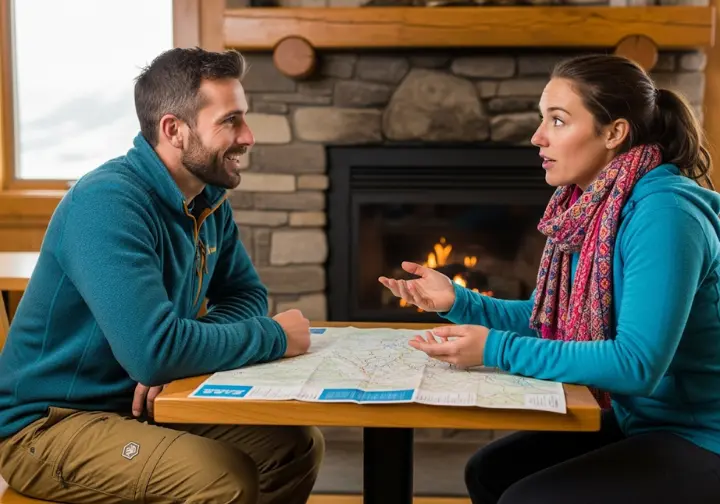
A certificate proves competence, but it doesn’t guarantee compatibility. Your guide is more than a risk manager; they are your partner, coach, and companion for the duration of your trip. A direct conversation via phone or video call is essential to assess the “soft skills” that can make or break an experience.
What Specific Questions Should You Ask in a Pre-Trip Interview?
This interview is your chance to understand their philosophy, communication style, and local knowledge. According to UIAA guidance on group dynamics in the mountains, clear communication is a cornerstone of safety. These questions are designed to open that door.
Pre-Trip Interview Checklist
- Experience & Local Knowledge:
- “How many times have you guided this specific route or objective?”
- “What are the most common challenges or reasons teams turn around on this objective?”
- “What is our backup plan or alternative objectives in the area if conditions don’t allow for our primary plan?”
- Risk Philosophy & Decision Making:
- “Can you describe your philosophy on turning around versus pushing for a summit in uncertain weather?”
- “Describe a time you had to manage a challenging client situation. What happened and how did you handle it?”
- Teaching Style & Communication:
- “How would you describe your guiding style? Is this trip primarily about reaching the objective, or is it also an instructional experience?”
- “How do you prefer to communicate throughout the day about pace, conditions, and decision-making?”
- “How do you manage groups where clients have slightly different skill or fitness levels?”
- Emergency Preparedness:
- “What is your specific emergency communication plan for this area?”
- “What devices do you carry (e.g., satellite messenger, personal locator beacon, satellite phone)?”
What Are the Final Steps Before Booking Your Trip?
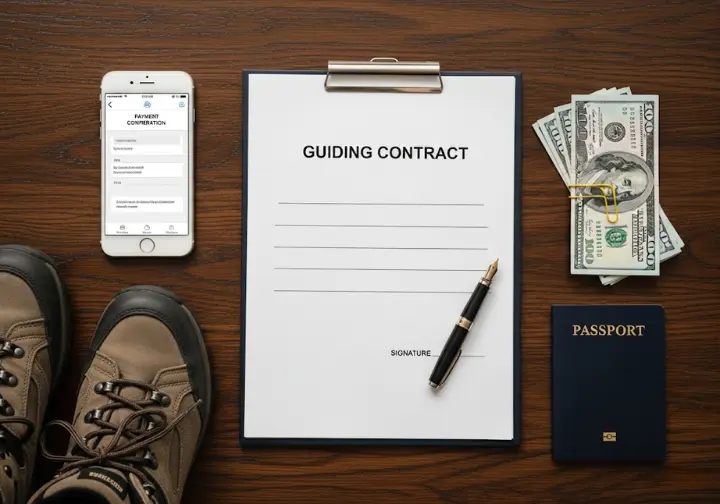
You’ve verified your guide’s credentials and you’ve assessed for compatibility. Now it’s time to finalize the logistics. These final steps ensure that all expectations are clear, documented, and professional, preventing misunderstandings down the road.
What Should Be Included in a Professional Guiding Contract?
A legitimate guide service will always operate with a clear, written agreement. Review it carefully before making any payment to secure your trip. A professional contract is a sign of a professional operation and protects both you and the guide.
- Inclusions & Exclusions: The agreement must explicitly state what the price covers (e.g., guide fees, permits, group gear) and what it does not (e.g., your travel, personal gear, insurance, guide gratuity).
- Policies: The cancellation and refund policy must be defined in detail. Understand the terms for both client-initiated cancellations (due to injury or other reasons) and guide-initiated cancellations (due to weather or unsafe conditions).
- Guide-to-Guest Ratio: The contract should state the confirmed guide-to-guest ratio for your specific trip. This is a critical factor for safety and the quality of your experience, and it should not be a surprise on the morning of the trip.
Understanding the financial components of a contract is a key skill, much like the one detailed in our guide to thru-hiking budget preparation.
What is the Standard Etiquette for Tipping a Backcountry Guide?
In the U.S. guiding industry, tipping is a standard and expected practice. Gratuities make up a significant portion of a guide’s income and are a way to show appreciation for a job well done.
The industry consensus for a tip is 10% to 20% of the total trip cost, based on the quality of service provided. For shorter day trips, a per-diem rate of $30 to $50 per person is also a common and appropriate guideline.
Your tip should reflect the guide’s professionalism, effort, communication, and overall role as a risk manager. It is crucial to understand that a tip should not be contingent solely on summit success, which is often dictated by weather, conditions, or other factors far beyond a guide’s control. The tip is typically given in cash directly to the lead guide at the conclusion of the trip.
Conclusion
Vetting a guide is a deliberate, two-part process that empowers you to take control of your safety and the quality of your adventure. It’s about combining objective verification with subjective assessment.
- First, you verify their technical competence. This is achieved by moving beyond trust and using the official databases of the AMGA, ACMG, and IFMGA to confirm their certifications.
- Second, you assess their personal compatibility. This is done through a structured pre-trip interview to ensure their communication style, risk philosophy, and teaching methods align with your goals.
Always remember the critical distinction between an “AMGA Accredited Business” and an “AMGA Certified Guide.” Your safety ultimately depends on the tested qualifications of the specific individual leading your trip. By adopting the “Trust, but Verify” approach outlined here, you take the single most powerful action to ensure you are hiring a legitimate, qualified professional for your next backcountry adventure.
Now that you’ve mastered how to vet a guide, explore our complete library of skill-building guides to become a more confident and self-reliant hiker.
Frequently Asked Questions about Vetting Backcountry Guides
Why should I hire a professional guide instead of going with a skilled friend?
A professional guide operates within a formal framework that a skilled friend, no matter how talented, does not. This includes standardized training and assessment, legal operating permits for public lands, commercial liability insurance, and adherence to professional security standards. They are paid to make sophisticated risk-reward decisions and are held accountable to a professional standard of care.
What is the difference between an AMGA Accredited business and an AMGA Certified guide?
Accreditation applies to a business and its operational standards, like having proper insurance and risk management plans. Certification applies to an individual and their tested, personal skills in a specific discipline like rock, ski, or alpine guiding. You must always verify the certification of the specific guide leading your trip, as an accredited business may employ guides with varying levels of qualification.
How much should I tip my backcountry guide?
The standard industry range in the U.S. is 10% to 20% of the total trip cost, based on the quality of the service provided. For day trips, a guideline of $30-$50 per person is also a common and appropriate amount. The tip reflects the guide’s professionalism and hard work, not just whether you reached a summit.
How far in advance should I book a guided trip?
For popular objectives (like Mt. Rainier or major European peaks) or during peak season, it is highly recommended to book 6 to 12 months in advance. The best guides and services are often booked a year out. For less common trips or during the shoulder season, 3 to 6 months may be sufficient, but booking early always provides more options and better availability.
Risk Disclaimer: Hiking, trekking, backpacking, and all related outdoor activities involve inherent risks which may result in serious injury, illness, or death. The information provided on The Hiking Tribe is for educational and informational purposes only. While we strive for accuracy, information on trails, gear, techniques, and safety is not a substitute for your own best judgment and thorough preparation. Trail conditions, weather, and other environmental factors change rapidly and may differ from what is described on this site. Always check with official sources like park services for the most current alerts and conditions. Never undertake a hike beyond your abilities and always be prepared for the unexpected. By using this website, you agree that you are solely responsible for your own safety. Any reliance you place on our content is strictly at your own risk, and you assume all liability for your actions and decisions in the outdoors. The Hiking Tribe and its authors will not be held liable for any injury, damage, or loss sustained in connection with the use of the information herein.
Affiliate Disclosure: We are a participant in the Amazon Services LLC Associates Program, an affiliate advertising program designed to provide a means for us to earn advertising fees by advertising and linking to Amazon.com. As an Amazon Associate, we earn from qualifying purchases. We also participate in other affiliate programs and may receive a commission on products purchased through our links, at no extra cost to you. Additional terms are found in the terms of service.



